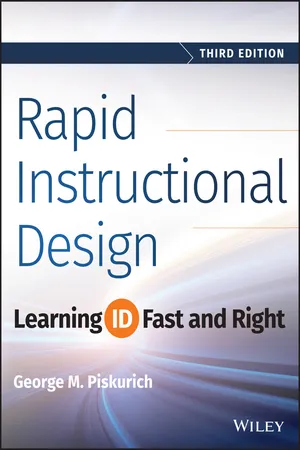
- English
- ePUB (mobile friendly)
- Available on iOS & Android
About this book
The classic guide to instructional design, fully updated for the new ways we learn
Rapid Instructional Design is the industry standard guide to creating effective instructional materials, providing no-nonsense practicality rather than theory-driven text. Beginning with a look at what "instructional design" really means, readers are guided step-by-step through the ADDIE model to explore techniques for analysis, design, development, intervention, and evaluation. This new third edition has been updated to cover new applications, technologies, and concepts, and includes many new templates, real-life examples, and additional instructor materials. Instruction delivery has expanded rapidly in the nine years since the second edition's publication, and this update covers all the major advances in the field. The major instructional models are expanded to apply to e-learning, MOOCs, mobile learning, and social network-based learning. Informal learning and communities of practice are examined, as well.
Instructional design is the systematic process by which instructional materials are designed, developed, and delivered. Designers must determine the learner's current state and needs, define the end goals of the instruction, and create an intervention to assist in the transition. This book is a complete guide to the process, helping readers design efficient, effective materials.
- Learn the ins and outs of the ADDIE model
- Discover shortcuts for rapid design
- Design for e-learning, Millennials, and MOOCs
- Investigate methods for emerging avenues of instruction
This book does exactly what a well-designed course should do, providing relevant guidance for anyone who wants to know how to apply good instructional design. Eminently practical and fully up-to-date, Rapid Instructional Design is the one-stop guide to more effective instruction.
Frequently asked questions
- Essential is ideal for learners and professionals who enjoy exploring a wide range of subjects. Access the Essential Library with 800,000+ trusted titles and best-sellers across business, personal growth, and the humanities. Includes unlimited reading time and Standard Read Aloud voice.
- Complete: Perfect for advanced learners and researchers needing full, unrestricted access. Unlock 1.4M+ books across hundreds of subjects, including academic and specialized titles. The Complete Plan also includes advanced features like Premium Read Aloud and Research Assistant.
Please note we cannot support devices running on iOS 13 and Android 7 or earlier. Learn more about using the app.
Information
Chapter 1
What Is This Instructional Design Stuff Anyway?
- Discover why you need instructional design
- Begin to see what instructional design is
- Consider the advantages and disadvantages of instructional design
WHY INSTRUCTIONAL DESIGN?
Table of contents
- Cover
- Title Page
- Copyright
- Tool List
- Preface for the Third Edition
- Introduction
- Chapter 1: What Is This Instructional Design Stuff Anyway?
- Chapter 2: Before You Do Anything: Pre-Instructional Design Activities
- Chapter 3: Do You Know What You Need to Do? Analysis
- Chapter 4: How to Do It: Design
- Chapter 5: Doing It Right: Development
- Chapter 6: Getting It Where It Does the Most Good: Implementation
- Chapter 7: Did It Do Any Good? Evaluation
- Chapter 8: Doing It Faster: More Rapid Design Shortcuts
- Chapter 9: Asynchronous e-Learning Design
- Chapter 10: Synchronous e-Learning Design
- Chapter 11: New Design Applications
- Glossary
- Suggested Readings
- Other Resources
- About the Author
- Index
- End User License Agreement